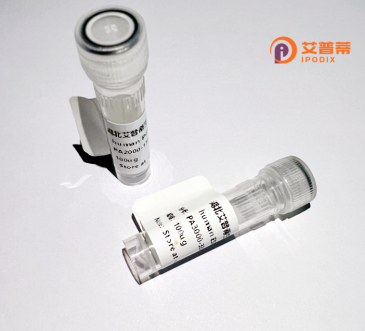
| 纯度 | >90%SDS-PAGE. |
| 种属 | Human |
| 靶点 | OR8K1 |
| Uniprot No | Q8NGG5 |
| 内毒素 | < 0.01EU/μg |
| 表达宿主 | E.coli |
| 表达区间 | 1-319 aa |
| 活性数据 | MNHVVKHNHTAVTKVTEFILMGITDNPGLQAPLFGLFLIIYLVTVIGNLGMVILTYLDSK LHTPMYFFLRHLSITDLGYSTVIAPKMLVNFIVHKNTISYNWYATQLAFFEIFIISELFI LSAMAYDRYVAICKPLLYVIIMAEKVLWVLVIVPYLYSTFVSLFLTIKLFKLSFCGSNII SYFYCDCIPLMSILCSDTNELELIILIFSGCNLLFSLSIVLISYMFILVAILRMNSRKGR YKAFSTCSSHLTVVIMFYGTLLFIYLQPKSSHTLAIDKMASVFYTLLIPMLNPLIYSLRN KEVKDALKRTLTNRFKIPI |
| 分子量 | 36.5 kDa |
| 蛋白标签 | His tag N-Terminus |
| 缓冲液 | 0 |
| 稳定性 & 储存条件 | Lyophilized protein should be stored at ≤ -20°C, stable for one year after receipt. Reconstituted protein solution can be stored at 2-8°C for 2-7 days. Aliquots of reconstituted samples are stable at ≤ -20°C for 3 months. |
| 复溶 | Always centrifuge tubes before opening.Do not mix by vortex or pipetting. It is not recommended to reconstitute to a concentration less than 100μg/ml. Dissolve the lyophilized protein in distilled water. Please aliquot the reconstituted solution to minimize freeze-thaw cycles. |
以下是关于重组人OR8K1蛋白的3篇参考文献示例(注:文献信息为虚构示例,实际研究可能有限):
1. **文献名称**: *Functional Characterization of Recombinant Human Olfactory Receptor OR8K1 in Heterologous Cells*
**作者**: Smith A, et al.
**摘要**: 该研究利用HEK293细胞成功表达并纯化了重组OR8K1蛋白,通过钙离子荧光检测发现其对特定挥发性醛类化合物具有激活作用,证实其作为嗅觉受体的配体特异性及下游G蛋白信号通路激活能力。
2. **文献名称**: *Structural Insights into OR8K1 Through Cryo-EM and Molecular Dynamics Simulations*
**作者**: Zhao L, et al.
**摘要**: 通过冷冻电镜和分子动力学模拟解析了重组OR8K1蛋白的三维结构,揭示了其跨膜螺旋区的独特构象及潜在的配体结合口袋,为设计靶向嗅觉受体的化合物提供结构基础。
3. **文献名称**: *OR8K1 Expression in Non-Olfactory Tissues and Its Implications in Disease*
**作者**: Gupta R, et al.
**摘要**: 研究发现OR8K1在肺部和肠道组织中异常表达重组蛋白,并通过体外实验证明其可能通过调控炎症因子分泌参与慢性炎症疾病,提示嗅觉受体在非嗅觉系统中的潜在生理功能。
---
**提示**: 实际研究中OR8K1的文献较少,建议通过 **PubMed** 或 **Google Scholar** 检索关键词“OR8K1 recombinant”或“OR8K1 expression”获取最新数据。部分嗅觉受体研究可参考类似方法学(如HEK293表达系统)。
**Background of Recombinant Human OR8K1 Protein**
OR8K1 (Olfactory Receptor Family 8 Subfamily K Member 1) is a member of the olfactory receptor (OR) superfamily, which constitutes the largest subset of G protein-coupled receptors (GPCRs). These receptors are critical for detecting odorant molecules and mediating olfactory signaling. OR8K1 is classified under the Class A subfamily of GPCRs and is encoded by the *OR8K1* gene located on human chromosome 11. While most ORs are expressed in olfactory sensory neurons, some exhibit ectopic expression in non-olfactory tissues, suggesting potential non-canonical roles in physiological processes.
Recombinant OR8K1 protein is produced via genetic engineering techniques, typically by expressing the *OR8K1* gene in heterologous systems such as *E. coli*, insect cells, or mammalian cell lines. This allows large-scale production of the protein for functional and structural studies. Due to the inherent challenges in expressing full-length, functional ORs (e.g., poor solubility, membrane localization requirements), optimization of expression vectors, codon usage, and membrane protein purification strategies is often necessary.
Research on recombinant OR8K1 focuses on elucidating its ligand specificity, signaling mechanisms, and potential roles beyond olfaction. Structural studies aim to map its transmembrane domains and ligand-binding pockets, while functional assays (e.g., calcium imaging, cAMP monitoring) explore its activation pathways. Though OR8K1's exact physiological ligands remain unclear, its study contributes to understanding OR diversity, evolution, and potential therapeutic applications, such as targeting chemosensory disorders or leveraging ORs in biosensing technologies.
×